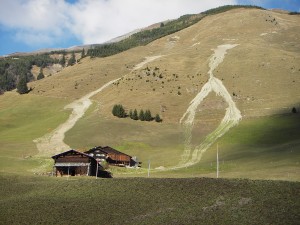8 October 2014
How rain falls – not just how much – may alter landslide risk
Posted by kwheeling
By Kate Wheeling

New research finds that it’s not just the amount of rain that falls on a hillside, but the pattern of rainfall that matters when trying to determine how likely a slope is to give way. This new information could improve forecasts of shallow landslides.
Credit: Christian Rickli
New research finds that it’s not just the amount of rain that falls on a hillside, but the pattern of rainfall that matters when trying to determine how likely a slope is to give way. This new information could improve forecasts of landslides, which are typically hard to predict, said the scientists conducting the research.
Different rainfall patterns—a short, heavy deluge, a light, steady downpour, or sporadic showers—will trigger different numbers of landslides with varying amounts of debris, according to the new study published today in Water Resources Research, a journal of the American Geophysical Union.
The study’s authors used this information about rainfall variability to develop a new model that factors in how different regions of a hillside redistribute the weight of the water depending on the amount, length and location of the rainfall.
“Classical models classify a hill slope section as unstable when the driving forces are higher than the resisting ones,” said Jonas von Ruette, who did his Ph.D. in the Soil and Terrestrial Environmental Physics (STEP) research group at ETH Zurich in Switzerland and the lead author of the new study. “In our model we went one step further.”
Driving forces, like the weight of water-logged earth on a hillside, are those that push the soil downward, while the resisting forces are those holding the earth in place, like the shear strength of the soil that arises mainly due to friction. The resisting strength of the hillside is influenced by soil type, depth, vegetation and prior damage to the soil from previous storms, which can vary across a hillside. Dead and decaying roots also leave behind irregular patterns of fissures, cracks and empty tunnels through which water flows and destabilizes the soil in unpredictable ways.
“There is a history embedded in the soil,” said von Ruette.
Because of these irregularities, different regions of a slope will respond differently to the water dumped on them during a rainstorm and will also react differently to various types of rainfall. How much rain falls and where it lands can affect how soil distributes the added weight of water.
The new model takes into account this more subtle load distribution behavior and how it is affected by changes in rainfall, von Ruette explained, leading to a more accurate simulation of landslide volume and frequency.
To simulate the effect of assorted rainfall patterns on landslides, the scientists ran their model with a wide range of variation in the amount of time it takes a storm to dump its rain and in where on the hillside the water lands. To keep the results anchored in the real world, they used actual data from a 2002 storm in the northern Alps that produced 53 millimeters (two inches) of rain and triggered landslides.
Varying artificial rainfall patterns indeed caused major differences in the numbers of simulated landslides, from as few as 30 to as many as 100. It also greatly influenced the total amount of debris those virtual landslides unleashed, from soil volumes of 3,000 cubic meters (105,944 cubic feet) to 60,000 cubic meters (2,118,880 cubic feet) in a catchment area of 2.4 km2 (0.92 square miles).
For now, the model can’t help to predict real-world landslides, the authors said, in part because of the resolution of current radar methods record only how much rain fell, not where it fell on the hillslope. Improving landslide prediction will also require more detailed information about the mountainsides themselves, said Thom Bogaard, an assistant professor of hillslope and land-degradation hydrology at Delft University of Technology in the Netherlands who was not involved in the new study.
“This model is a good and important contribution, and a logical step in the development that is going on in hydromechanical modeling,” said Bogaard. “It’s an important step forward for [landslide] risk assessment.”
– Kate Wheeling is a science writing intern in the AGU’s Public Information department.










 GeoSpace is a blog on Earth and space science, managed by AGU’s Public Information staff. The blog features posts by AGU writers and guest contributors on all sorts of relevant science topics, but with a focus on new research and geo and space sciences-related stories that are currently in the news.
GeoSpace is a blog on Earth and space science, managed by AGU’s Public Information staff. The blog features posts by AGU writers and guest contributors on all sorts of relevant science topics, but with a focus on new research and geo and space sciences-related stories that are currently in the news.